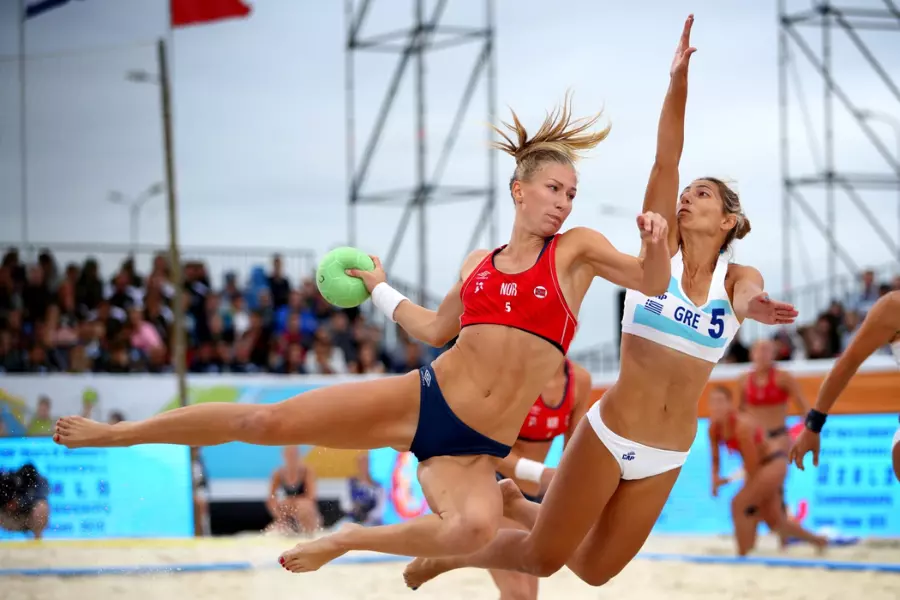Beach volleyball is an Olympic sport since 1996, so know the rules.
Among the world’s most popular recreational activities is beach volleyball.
In the early 1920s, beach volleyball became popular in Santa Monica, California, where it became a favourite leisure activity among residents. It was a descendant of indoor volleyball, which was founded in 1895.
Local tournaments were also held in many Californian beach clubs.
Although beach volleyball’s rules remained largely the same throughout the 1920s as the indoor version, at the Santa Monica Athletic Club, players began experimenting with just two players per side of the court, a format that became popular among professional beach players.
In 1976, the Olympic World Championship of Beach Volleyball was held at the Will Rogers State Beach in Pacific Palisades, California during Labor Day weekend. This competition was won by the UCLA Bruins duo of Greg Lee and Jim Menges.
Beach volleyball Rules

Basic Rules of Beach Volleyball
Court dimensions
Men have a net height of 2.43 meters, while women have a net height of 2.24 meters. Beach volleyball courts measure 16 meters by 8 meters.
Team composition
On every serve, both teams can score points, with the game following a rally scoring system.
Serving Rules
Types of serves
The skyball serve, float serve, and jump serve can all be used by players. To serve, the ball must be struck behind the end line and clear the net.
Service faults
Stepping on or over the end line during service and serving the ball into the net are common service errors.
Passing and Setting Rules
Techniques for passing
When passing the ball to their partner, players use forearm passing or overhead passing techniques.
Rules for setting
In setting, the ball is redirected to a teammate for an attack using fingertips. During setting, it is considered a fault to double contact or lift the ball.
Attacking Rules
Types of attacks
Various techniques can be used to attack, such as spiking, tipping, or rolling shots. To score, the attacking player must avoid blockers and send the ball to the opponent’s court.
Attacking faults
Foot faults, touching the net, or attacking the ball out of bounds are common attacking mistakes.
Blocking Rules
Legal blocking actions
Blocking the opponent’s attack can be done with the player’s hands, but the ball must not be touched beyond the net.
Blocking faults
Among the blocking faults are reaching over the net or making contact with the opponent during or before the attack.
Defensive Rules
Digging techniques
A dig involves regaining possession of the ball after the opponent’s attack has been made by using forearm passing techniques.
Defensive positioning
Strategic positioning is crucial to effectively defending the court against an opponent’s attack.
Substitution Rules
When substitutions are allowed
In dead ball situations, substitutions are permitted, but the referee must be notified.
Limitations on substitutions
Players can only enter or exit the game when signaled by the referee, and teams are allowed only a limited number of substitutions per set.
You may enjoy reading How to Play Beach Volleyball?
Key differences between indoor and beach volleyball

Beach volleyball teams can only field two players per side on the court, unlike indoor volleyball, in which both teams field six players each. Substitutions are not allowed in beach volleyball.
Beach volleyball is played on a sand court, as opposed to the hardcourt of indoor volleyball.
To determine which team serves first, a coin toss is conducted. When winning a point, both players on the team must serve alternately.
Beach volleyball rules and scoring system
Unlike indoor volleyball, beach volleyball matches are best-of-three sets, while indoor volleyball matches can last up to five sets.
Unlike the indoor version for its first four sets, in the outdoor version the first two sets are played until a team reaches 21 points, and the third set and final deciding set are played to 15 points if needed.
To effectively win a set, a team must have at least two points in front of their opponent and reach the designated points total – 21 in the first two sets and 15 in the third – during each rally.
Thus, if the score is 20-20 in the first two sets or 14-14 in the decider, the set continues until one team gains a two-point lead.
In beach volleyball, if neither team wins the first two sets and the game progresses to a third and final set, the team serving first in the decider is decided by a coin toss.
You may enjoy reading Beach Volleyball Near Me
Beach volleyball player positions

Blocker
With his or her longer reach and quick reflexes, the blocker defends the net and contests the opponent’s spikes.
Defender
In the open areas of the court, the defender defends the rest of the court, digs out spikes, and chases looped up shots. It takes tremendous acceleration to get across the court and maintain rallies for the defender, who is usually the more agile of the two teammates.
In contrast to indoor volleyball, where teams have five defined roles per player, teams in beach volleyball usually use both their blockers and defenders depending on whether the player is guarding the left- or right-side of the court.
Winning a point in beach volleyball
As opposed to indoor volleyball, where the spike is predominantly used to end rallies, outdoor volleyball provides a much greater variety of creative ways to score points.
It is when a player loops the ball over the net and over an opponent’s block with a lot of topspin, giving it a sharp downward trajectory, leaving the defender with only a fraction of a second to react.
It is extremely hard for the defender to read and recover from a cut shot, which is a ball hit across the court into the sand and close to the net in the opposition’s half.
Pokeys are when a player drops the ball with his knuckles into open spaces.
An attempted block is the only way for a player to touch the ball two consecutive times in outdoor volleyball.
Serving over the end line, hitting the ball more than three times and having the ball bounce out of bounds are all causes for a losing score.
You may enjoy reading What If Every Sport Was Photographed Like Beach Volleyball?
Beach volleyball court size and equipment

In beach volleyball, the court size is smaller because there are fewer players, and the ball is lighter because it cannot be moved as quickly on sand as in indoor volleyball.
Beach volleyball courts are 16 meters (52.5 feet) long and 8 meters (26.2 feet) wide, per FIVB guidelines.
Men’s beach volleyball net height is 2.43m (7.97ft) and women’s beach volleyball net height is 2.24m (7.35ft).
FIVB regulations require beach volleyball balls to weigh 260-280gm (9.2-9.87 ounces), measure 66-68cm (25.98-26.77 inches), and have a pressure of 2.48-3.20 psi.
You may enjoy reading How Does Beach Volleyball Work?
Olympics Beach Volleyball winners

During the 1992 Summer Olympics in Barcelona, beach volleyball was a demonstration sport for men and women, but it only made its official debut at the 1996 Summer Olympics in Atlanta.
| Olympics | Winners | Team |
| Atlanta 1996 | USA | Karch Kiraly and Kent Steffes |
| Sydney 2000 | USA | Dain Blanton and Eric Fonoimoana |
| Athens 2004 | Brazil | Emanuel Rego and Ricardo Santos |
| Beijing 2008 | USA | Phil Dalhausser and Todd Rogers |
| London 2012 | Germany | Julius Brink and Jonas Reckermann |
| Rio 2016 | Brazil | Alison Cerutti and Bruno Oscar Schmidt |
| Tokyo 2020 | Norway | Anders Mol and Christian Sørum |
| Olympics | Winners | Team |
| Atlanta 1996 | Brazil | Sandra Pires and Jackie Silva |
| Sydney 2000 | Australia | Natalie Cook and Kerri Pottharst |
| Athens 2004 | USA | Misty May-Treanor and Kerri Walsh Jennings |
| Beijing 2008 | USA | Misty May-Treanor and Kerri Walsh Jennings |
| London 2012 | USA | Misty May-Treanor and Kerri Walsh Jennings |
| Rio 2016 | Germany | Laura Ludwig and Kira Walkenhorst |
| Tokyo 2020 | USA | Alix Klineman and April Ross |
FAQs
What are the basic skills needed to play beach volleyball?
Beach volleyball requires skills such as serving, passing, setting, attacking, blocking, and defense.
How does beach volleyball differ from indoor volleyball?
Wind and sun make beach volleyball more dynamic because it is played on sand courts with fewer players.
Can players touch the net during a rally?
It is not allowed to touch the net during a rally.
Is it legal to play the ball with any part of the body in beach volleyball?
The ball can be played legally with any part of the body, including the hands, forearms, and feet.
Are there any specific clothing requirements for beach volleyball?
Beach attire is not strictly required, but players typically wear comfortable athletic clothing.
What are the basic skills needed to play beach volleyball?
Serving, passing, setting, attacking, blocking, and defending are among the basic skills.
How does beach volleyball differ from indoor volleyball?
In beach volleyball, players play on sand courts with fewer players, and wind and sun play a major role in making the game more dynamic.
Can players touch the net during a rally?
The net cannot be touched during a rally, as it constitutes a fault.
Is it legal to play the ball with any part of the body in beach volleyball?
All parts of the body, including hands, forearms, and even feet, can legally play the ball.
Are there any specific clothing requirements for beach volleyball?
Players typically wear comfortable athletic clothing suitable for a beach setting, while there are no strict clothing requirements.
Conclusion
For players and fans alike to enhance their enjoyment of beach volleyball, it is essential to understand its rules. No matter how experienced you are or whether you’re a beginner, following the rules ensures fair play and enhances the beach volleyball experience.
Also, read Why Do Beach Volleyball Players Exhibit Cameltoe?





